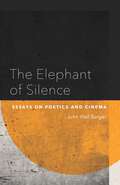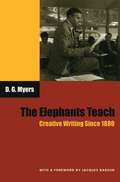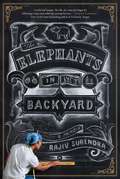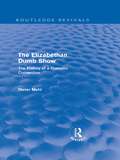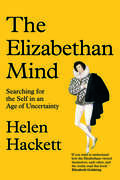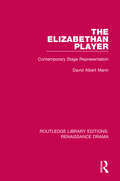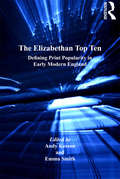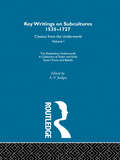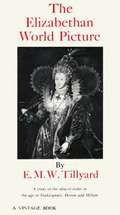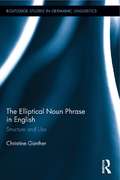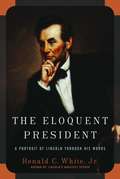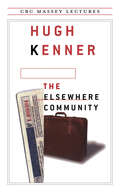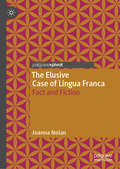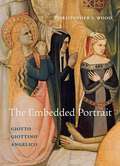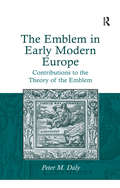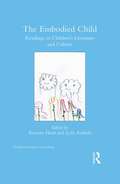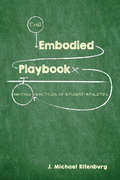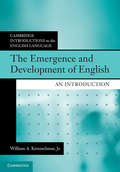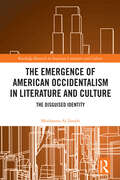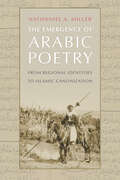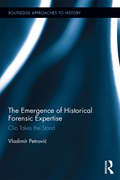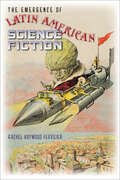- Table View
- List View
The Elephant of Silence: Essays on Poetics and Cinema
by John Wall Barger“A poem is an act of faith because the poet believes in it,” contends John Wall Barger in The Elephant of Silence, a collection of essays exploring forms of knowing (and not knowing) that awaken a poetic mind. By considering poetry, film, and the intersections among aesthetic moments and our lives, Barger illuminates the foundations of poetic craft but also probes how to be alive, creative, and open in the world. Each piece investigates unanswerable questions and indefinable words: Lorca’s duende, Nabokov’s poshlost, Bashō’s underglimmer, Huizinga’s ludic, Tarkovsky’s Zona. Influenced by poets such as Glück and Ruefle, and filmmakers such as Kubrick and Lynch, Barger writes—first always sharing his own personal life stories—on the nature of perception, experience, and the human mind. With lyric eloquence and disarming candor, The Elephant of Silence tackles how to live an imaginative life, how to gravitate toward the silence from which art comes, and how the mystical is also the everyday.
The Elephants Teach: Creative Writing Since 1880
by David Gershom MyersWhen Vladimir Nabokov was up for a chair in literature at Harvard, the linguist Roman Jakobson protested: “What’s next? Shall we appoint elephants to teach zoology?” That anecdote, with which D. G. Myers begins The Elephants Teach, perfectly frames the issues this book tackles. Myers explores more than a century of debate over how writing should be taught and whether it can or should be taught in a classroom at all. Along the way, he incorporates insights from a host of poets and teachers, including Henry Wadsworth Longfellow, Ralph Waldo Emerson, Robert Frost, John Berryman, John Dewey, Lionel Trilling, Robert Lowell, Ezra Pound, and Saul Bellow. And from his exhaustive research, Myers extracts relevant background information on nineteenth-century educational theory; shifts in technology, publishing, and marketing; the growth of critical theory in this country; and the politics of higher education. While he shows how creative writing has become a machine for creating more creative writing programs, Myers also suggests that its history supplies a precedent for something different—a way for creativity and criticism, poetry and scholarship, to join together to produce not just writing programs but good writers. Updated with fresh commentary on what’s happened to creative writing in the academy since the first edition was published ten years ago, The Elephants Teach will be indispensable for students and teachers of writing, literature, and literary history.
The Elephants in My Backyard: A Memoir
by Rajiv SurendraRajiv Surendra was filming Mean Girls, playing the beloved rapping mathlete Kevin Gnapoor, when a cameraman insisted he read Yann Martel's Life of Pi. So begins his "lovely and human" (Jenny Lawson, author of Furiously Happy) tale of obsessively pursuing a dream, overcoming failure, and finding meaning in life."This was a once-in-a-lifetime chance. I found myself standing dangerously close to the edge of a cliff. Far below me was an incredible abyss with no end in sight. I could turn back and safely return to where I had come from, or I could throw caution to the wind, lift my arms up into the air . . . and jump." --From The Elephants in My Backyard What happens when you spend ten years obsessively pursuing a dream, and then, in the blink of an eye, you learn that you have failed, that the dream will not come true? In 2003, Rajiv Surendra was filming Mean Girls, playing the beloved rapping mathlete Kevin Gnapoor, when a cameraman insisted he read Yann Martel's Life of Pi. Mesmerized by all the similarities between Pi and himself--both are five-foot-five with coffee-colored complexions, both share a South Indian culture, both lived by a zoo--when Rajiv learns that Life of Pi will be made into a major motion picture he is convinced that playing the title role is his destiny. In a great leap of faith Rajiv embarks on a quest to embody the sixteen-year-old Tamil schoolboy. He quits university and buys a one-way ticket from Toronto to South India. He visits the sacred stone temples of Pondicherry, he travels to the frigid waters off the coast of rural Maine, and explores the cobbled streets of Munich. He befriends Yann Martel, a priest, a castaway, an eccentric old woman, and a pack of Tamil schoolboys. He learns how to swim, to spin wool, to keep bees, and to look a tiger in the eye. All the while he is really learning how to dream big, to fail, to survive, to love, and to become who he truly is. Rajiv Surendra captures the uncertainty, heartache, and joy of finding ones place in the world with sly humor and refreshing honesty. The Elephants in My Backyard is not a journey of goals and victories, but a story of process and determination. It is a spellbinding and profound book for anyone who has ever failed at something and had to find a new path through life.
The Elizabethan Country House Entertainment
by Elizabeth Zeman KolkovichThis is the first full-length critical study of country house entertainment, a genre central to late Elizabethan politics. It shows how the short plays staged for the Queen at country estates like Kenilworth Castle and Elvetham shaped literary trends and intervened in political debates, including whether women made good politicians and what roles the church and local culture should play in definitions of England. In performance and print, country house entertainments facilitated political negotiations, rethought gender roles, and crafted regional and national identities. In its investigation of how the hosts used performances to negotiate local and national politics, the book also sheds light on how and why such entertainments enabled female performance and authorship at a time when English women did not write or perform commercial plays. Written in a lively and accessible style, this is fascinating reading for scholars and students of early modern literature, theatre, and women's history.
The Elizabethan Dumb Show: The History of a Dramatic Convention (Routledge Revivals)
by Dieter MehlFirst published in English in 1965, this book discusses the roots and development of the dumb show as a device in Elizabethan drama. The work provides not only a useful manual for those who wish to check the occurrence of dumb shows and the uses to which they are put; it also makes a real contribution to a better understanding of the progress of Elizabethan drama, and sheds new light on some of the lesser known plays of the period.
The Elizabethan Mind: Searching for the Self in an Age of Uncertainty
by Helen HackettThe first comprehensive guide to Elizabethan ideas about the mind What is the mind? How does it relate to the body and soul? These questions were as perplexing for the Elizabethans as they are for us today—although their answers were often startlingly different. Shakespeare and his contemporaries believed the mind was governed by the humours and passions, and was susceptible to the Devil&’s interference. In this insightful and wide-ranging account, Helen Hackett explores the intricacies of Elizabethan ideas about the mind. This was a period of turbulence and transition, as persistent medieval theories competed with revived classical ideas and emerging scientific developments. Drawing on a wealth of sources, Hackett sheds new light on works by Shakespeare, Marlowe, Sidney, and Spenser, demonstrating how ideas about the mind shaped new literary and theatrical forms. Looking at their conflicted attitudes to imagination, dreams, and melancholy, Hackett examines how Elizabethans perceived the mind, soul, and self, and how their ideas compare with our own.
The Elizabethan Player: Contemporary Stage Representation (Routledge Library Editions: Renaissance Drama)
by David Albert MannIn this book, first published in 1991, David Mann argues for more attention to the performer in the study of Elizabethan plays and less concern for their supposed meanings and morals. He concentrates on a collection of extracts from plays which show the Elizabethan actor as a character onstage. He draws from the texts a range of issues concerning performance practice: the nature of iterance; doubling and its implications for presentational acting; the importance of clowning and improvisation; and the effects of audience and venue on the dynamics of performance. The author suggests that the stage representation of players is in part a nostalgic farewell to the passing of an impure but perhaps more vital theatre, and in part an acknowledgement of the threat the adult theatre’s growing sophistication offered to its institutional and adolescent rivals. This title will be of interest to students of Drama and Performance.
The Elizabethan Top Ten: Defining Print Popularity in Early Modern England (Material Readings in Early Modern Culture)
by Emma SmithEngaging with histories of the book and of reading, as well as with studies of material culture, this volume explores ’popularity’ in early modern English writings. Is ’popular’ best described as a theoretical or an empirical category in this period? How can we account for the gap between modern canonicity and early modern print popularity? How might we weight the evidence of popularity from citations, serial editions, print runs, reworkings, or extant copies? Is something that sells a lot always popular, even where the readership for print is only a small proportion of the population, or does popular need to carry something of its etymological sense of the public, the people? Four initial chapters sketch out the conceptual and evidential issues, while the second part of the book consists of ten short chapters-a ’hit parade’- in which eminent scholars take a genre or a single exemplar - play, romance, sermon, or almanac, among other categories-as a means to articulate more general issues. Throughout, the aim is to unpack and interrogate assumptions about the popular, and to decentre canonical narratives about, for example, the sermons of Donne or Andrewes over Smith, or the plays of Shakespeare over Mucedorus. Revisiting Elizabethan literary culture through the lenses of popularity, this collection allows us to view the subject from an unfamiliar angle-in which almanacs are more popular than sonnets and proclamations more numerous than plays, and in which authors familiar to us are displaced by names now often forgotten.
The Elizabethan Underworld - a collection of Tudor and Early Stuart Tracts and Ballads: Previously published 1930 and 1965 (Key Writings On Subcultures, 1535-1727 Ser. #Vol. 1)
by A. V. JudgesThe Elizabethan Underworld collects together sixteen of the more important tracts from the sixteenth and early seventeenth centuries dealing with the lives and misdoings of thieves, rogues, and tricksters. For the most part the original authors were men of experience - watchmen, constables and those who drifted into the London underworld and learnt its tricks. A thorough introduction contributes a full historical background and outlines contemporary social contexts.
The Elizabethan World Picture
by E. M. W. TillyardMy object then is to extract and expound the most ordinary beliefs about the constitution of the world as pictured in the Elizabethan age and through this exposition to help the ordinary reader to understand and to enjoy the great writers of the age. In attempting this I have incidentally brought together a number of pieces of elementary lore which I have not found assembled elsewhere. This book may actually be a convenient factual aid to the bare construing of some of Spenser or Donne or Milton.
The Elizabethan World Picture
by E. M. W. TillyardThis illuminating account of ideas of world order prevalent in the Elizabethan Age and later is an indispensable companion for readers of the great writers of the sixteenth and seventeenth centuries Shakespeare and the Elizabethan dramatists, Donne and Milton, among many others. The basic medieval idea of an ordered Chain of Being is studied by Tillyard in the process of its various transformations by the dynamic spirit of the Renaissance. Among his topics are: Angels; the Stars and Fortune; the Analogy between Macrocosm and Microcosm; the Four Elements; the Four Humors; Sympathies; Correspondences; and the Cosmic Dance ideas and symbols that inspirited the imaginations not only of the Elizabethans, but also of the Renaissance as such.This idea of cosmic order was one of the genuine ruling ideas of the Elizabethan Age, and perhaps the most characteristic. Such ideas, like our everyday manners, are the least disputed and the least paraded in the creative literature of the time. The province of this book is some of the notions about the world and man that were quite frequently taken for granted by the ordinary educated Elizabethan; the commonplaces too familiar for the poets to make detailed use of, except in explicitly educational passages, but essential as basic assumptions and invaluable at moments of high passion.The objective of The Elizabethan World Picture is to extract and explain the most ordinary beliefs about the constitution of the world as pictured in the Elizabethan Age and through this exposition to help the ordinary reader to understand and to enjoy the great writers of the age. In attempting this, Tillyard has brought together a number of pieces of elementary lore. This classic text is a convenient factual aid to extant interpretations of some of Spenser, Donne, or Milton.
The Elliptical Noun Phrase in English: Structure and Use (Routledge Studies in Germanic Linguistics)
by Christine GüntherThis book presents a detailed analysis of structural as well as pragmatic aspects underlying the phenomenon of noun ellipsis in English. Here Günther examines the structure of elliptical noun phrases to account for the conditions on noun ellipsis and those on one-insertion, with special emphasis on the (oft-neglected) parallels between the two. She also examines the use of noun ellipsis with adjectives in order to shed light on this under-researched phenomenon, drawing on data from the British National Corpus.
The Eloquent President: A Portrait of Lincoln Through His Words
by Ronald C. White Jr.Analysis of Lincoln's speeches and the events surrounding them.
The Elsewhere Community (The CBC Massey Lectures)
by Hugh KennerAcclaimed literary critic Hugh Kenner examines Western culture's insatiable need for stimulation encountered elsewhere - from the eighteenth century's Grand Tour, to the self-imposed exile of modernist writers, to the disembodied global journeys the Internet avails us today. Kenner brings to this fascinating study knowledge of a wide array of disciplines. Hugh Kenner has written on topics ranging from geodesic domes to Bugs Bunny, but is perhaps best known for The Pound Era, his definitive study of Ezra Pound's life and work.
The Elusive Case of Lingua Franca: Fact and Fiction
by Joanna NolanThis book explores many of the unanswered questions surrounding the original and eponymous Lingua Franca, a language spoken by peoples across the Mediterranean and North Africa for nearly three centuries. Allowing people from different countries, classes and cultures to interact with one another for the purposes of trade, piracy, slavery and diplomacy - among many other domains - Lingua Franca was lexified by Romance languages, including Italian and its dialects, Spanish, French and Portuguese, with possible Turkish and Arabic influences as well. The potential unreliability of source accounts, the blurring of fact and fiction across documentary and dramatic sources, and the linguistic biases and plurilingual repertoire of many of Lingua Franca’s speakers all combine to make Lingua Franca an elusive topic for examination. The author draws upon previously unexplored documentary evidence, including correspondence from the era found in The National Archives at Kew, to shed light on the multilingual and plurilingual landscape that fostered Lingua Franca’s development and spread, and its influence on the written domain. This book will be of interest to students and scholars of colonial history, linguistic anthropology, sociolinguistics and language contact.
The Embedded Portrait: Giotto, Giottino, Angelico
by Christopher S. WoodA new study of the early Renaissance portraitIn fourteenth-century Italy, ever more women and men—not only clergy but also laity—introduced their own portraits into sacred paintings. Images of modern supplicants, submissive and prayerful, shared space with the holy narratives. The portraits mimicked the first worshippers of Christ: Mary, the Three Magi, Mary Magdalene. At the same time, they modeled, for modern viewers, ideal involvement in the emotion-laden stories. In The Embedded Portrait, Christopher S. Wood traces these incursions of the real and profane into Florentine sacred painting between Giotto and Fra Angelico.The portraits not only intruded upon a sacred space, but also intervened in an artwork. The pressure exerted by the modern interlopers—their lives and experiences, implied by their portraits—threatened the formal closure that had served as a powerful symbolic form of the pact between God and humans. The Embedded Portrait reconstructs this art historical drama from the point of view of the artists rather than the patrons. Following clues left by Vasari, the book assigns a leading role to the painter Giottino, or &“little Giotto.&” Little-known today but highly regarded in his lifetime, Giottino proposed a new manner of painting that was later realized by Fra Angelico through his own innovative approach to the problem of the embedded portrait.Seeking not to stabilize the artworks but to extend their reach, the interpretations offered in The Embedded Portrait re-create and update the psychic and libidinal energies that gave rise to these works in the first place.
The Emblem in Early Modern Europe: Contributions to the Theory of the Emblem
by Peter M. DalyThe emblem was big business in early-modern Europe, used extensively not only in printed books and broadsheets, but also to decorate pottery, metalware, furniture, glass and windows and numerous other domestic, devotional and political objects. At its most basic level simply a combination of symbolic visual image and texts, an emblem is a hybrid composed of words and picture. However, as this book demonstrates, understanding the precise and often multiple meaning, intention and message emblems conveyed can prove a remarkably slippery process. In this book, Peter Daly draws upon many years’ research to reflect upon the recent upsurge in scholarly interest in, and rediscovery of, emblems following years of relative neglect. Beginning by considering some of the seldom asked, but important, questions that the study of emblems raises, including the importance of the emblem, the truth value of emblems, and the transmission of knowledge through emblems, the book then moves on to investigate more closely-focussed aspects such as the role of mnemonics, mottoes and visual rhetoric. The volume concludes with a review of some perhaps inadequately considered issues such as the role of Jesuits (who had a role in the publication of about a quarter of all known emblem books), and questions such as how these hybrid constructs were actually read and interpreted. Drawing upon a database containing records of 6,514 books of emblems and imprese, this study suggests new ways for scholars to approach important questions that have not yet been satisfactorily broached in the standard works on emblems.
The Emblematics of the Self
by Elizabeth B. BeardenThe ancient Greek romances of Achilles Tatius and Heliodorus were widely imitated by early modern writers such as Miguel de Cervantes, Philip Sidney, and Mary Wroth. Like their Greek models, Renaissance romances used ekphrasis, or verbal descriptions of visual representation, as a tool for characterization. The Emblematics of the Self shows how the women, foreigners, and non-Christians of these tales reveal their identities and desires in their responses to the 'verbal pictures' of romance. Elizabeth B. Bearden illuminates how 'verbal pictures' enliven characterization in English, Spanish, and Neolatin romances from 1552 to 1621. She notes the capacity for change among characters -- such as cross-dressed Amazons, shepherdish princesses, and white Mauritanians -- who traverse transnational cultural and aesthetic environments. Engaging and rigorous, The Emblematics of the Self breaks new ground in understanding hegemonic and cosmopolitan European conceptions of the 'other,' as well as new possibilities for early modern identities, in an increasingly global Renaissance.
The Embodied Child: Readings in Children’s Literature and Culture (Children's Literature and Culture)
by Lydia Kokkola Roxanne HardeThe Embodied Child: Readings in Children’s Literature and Culture brings together essays that offer compelling analyses of children’s bodies as they read and are read, as they interact with literature and other cultural artifacts, and as they are constructed in literature and popular culture. The chapters examine the ideology behind the cultural constructions of the child’s body and the impact they have on society, and how the child’s body becomes a carrier of cultural ideology within the cultural imagination. They also consider the portrayal of children’s bodies in terms of the seeming dichotomies between healthy-vs-unhealthy bodies as well as able-bodied-vs-disabled, and examines flesh-and-blood bodies that engage with literary texts and other media. The contributors bring perspectives from anthropology, communication, education, literary criticism, cultural studies, philosophy, physical education, and religious studies. With wide and astute coverage of disparate literary and cultural texts, and lively scholarly discussions in the introductions to the collection and to each section, this book makes a long-needed contribution to discussions of the body and the child.
The Embodied Playbook: Writing Practices of Student-Athletes
by J. Michael RifenburgThe Embodied Playbook discovers a new approach to understanding student literacy in a surprising place: the university athletics department. Through analysis of a yearlong case study of the men’s basketball team at the University of North Georgia, J. Michael Rifenburg shows that a deeper and more refined understanding of how humans learn through physical action can help writing instructors reach a greater range of students. Drawing from research on embodiment theory, the nature and function of background knowledge, jazz improvisation, and other unexpected domains, The Embodied Playbook examines a valuable but unexplored form of literacy: the form used by student-athletes when learning and using scripted plays. All students’ extracurricular prior knowledge is vital for the work they undertake in the classroom, and student-athletes understand the strengths and constraints of written text much as they understand the text of game plays: through embodying text and performing it in a competitive space. The book focuses on three questions: What are plays and what do they do? How do student-athletes learn plays? How can teachers of composition and rhetoric better connect with student-athletes? The Embodied Playbook reveals the literacy of the body as a rich and untapped resource for writing instruction. Given the numbers of students who are involved in athletics, whether intramural, community-related, or extracurricular, Rifenburg’s conclusions hold important implications not only for how we define literacy but also for how writing programs can serve all of their students most effectively.
The Emergence and Development of English: An Introduction (Cambridge Introductions to the English Language)
by William A. Kretzschmar JrThis textbook provides a step-by-step introduction to the history of the English language (HEL), offering a fresh perspective on the process of language change. Aimed at undergraduate students, The Emergence and Development of English is accessibly written, and contains a wealth of pedagogical tools, including chapter openers, key terms, chapter summaries, end-of-chapter exercises and suggestions for further reading. A central theme of the book is 'emergence', the key term from the study of complex systems, which describes how massive numbers of random verbal interactions give rise to regularities that 'emerge' without specific causes. This unique approach encourages readers to incorporate complex systems into the mainstream coverage of HEL. Additional resources include examples of language from each period as well as appendices on terminology, online resources and audio samples.
The Emergence of American Occidentalism in Literature and Culture: The Disguised Identity (Routledge Research in American Literature and Culture)
by Muthanna Al-JanabiThe book presents an innovative conceptualization of Western thought, casting the discourse of black and white intellectuals and politicians as a treatise on Occidentalism. It envisions American Occidentalism as an inner discourse where Critical Occidentalists interact textually and historically in response to the prevailing crosscurrents. To capture this narrativity, the first chapter establishes the book’s new terminology, rereads ancient Greek texts, and critiques the works of key anthropologists like James G. Carrier and Fernando Coronil, as well as cultural theorists such as Hassan Hanafi, Xiaomei Chen, and Ian Buruma and Avishai Margalit. The other three chapters analyze the Occidentalist tendency in the discursive, official, and intellectual practices of the Early Republic, the twentieth century, and the twenty-first century. Ideal for scholars and individuals interested in postcolonial theory, (African) American literature, and political sciences, this book challenges readers to see the Occident not as a fixed entity, but as a dynamic, self-critical tradition.
The Emergence of Arabic Poetry: From Regional Identities to Islamic Canonization
by Nathaniel A. MillerA new literary history of Arabic poetry from 500–750 CE that includes hundreds of lines of poetry never before translated into EnglishTo interpret the Quran’s Arabic, early medieval Muslims turned to pre-Islamic poetry, a corpus that the Prophet Muhammad’s cousin called “the archive of the Arabs.” While this principle seems straightforward, pre-Islamic Arabs did not, in fact, think of themselves as either pre-Islamic or Arab. The term Arab barely appears at all in pre-Islamic poetry.The Emergence of Arabic Poetry reexamines this early poetry to reconstruct what pre-Islamic culture actually entailed. Nathaniel A. Miller draws on a wide range of texts, including hundreds of lines of poetry never before translated into English—in addition to new inscriptional, archaeological, and non-Arabic sources—to explore the diverse world of pre- and early-Islamic Arabia in which Islam developed. Miller traces the emergence of two regional identities, and their distinctive poetic traditions, in the Arabian Peninsula of late antiquity: Najdi in the center and northeast and Hijazi in the southwest. The book shows how later efforts of Muslim scholars to use early poetry as an aesthetic, linguistic ideal to interpret the Quran resulted in an image of a unitary, exceptional, and isolated Arab identity and culture. These scholars drew on the Najdi tradition, canonizing its forms as classical Arabic poetry par excellence, and solidifying many tropes of Arabness that are still ubiquitous today: of nomadism, performative generosity, and martial equestrianism. However, Miller argues, it was the neglected Hijazi tradition that was actually more central to the emergence of early Islam.Early Arabic poetry has been largely overlooked in current scholarship in adjacent fields, largely due to twentieth-century controversies over whether this corpus is legitimate or was forged. In combining a reconstruction of pre-Islamic poetry’s social function with a consideration of the circumstances of its later canonization, The Emergence of Arabic Poetry offers an urgently needed reappraisal of a significant but underexamined poetic corpus, as well as a new literary history of the origins of Arabic poetry from 500 to 750 CE.
The Emergence of Historical Forensic Expertise: Clio Takes the Stand (Routledge Approaches to History)
by Vladimir PetrovićThis book scrutinizes the emergence of historians participating as expert witnesses in historical forensic contribution in some of the most important national and international legal ventures of the last century. It aims to advance the debate from discussions on whether historians should testify or not toward nuanced understanding of the history of the practice and making the best out of its performance in the future.
The Emergence of Latin American Science Fiction (Early Classics of Science Fiction)
by Rachel Haywood FerreiraA fantastic voyage through the early science fiction of Latin America Early science fiction has often been associated almost exclusively with Northern industrialized nations. In this groundbreaking exploration of the science fiction written in Latin America prior to 1920, Rachel Haywood Ferreira argues that science fiction has always been a global genre. She traces how and why the genre quickly reached Latin America and analyzes how writers in Argentina, Brazil, and Mexico adapted science fiction to reflect their own realities. Among the texts discussed are one of the first defenses of Darwinism in Latin America, a tale of a time-traveling history book, and a Latin American Frankenstein. Latin American science fiction writers have long been active participants in the sf literary tradition, expanding the limits of the genre and deepening our perception of the role of science and technology in the Latin American imagination. The book includes a chronological bibliography of science fiction published from 1775 to 1920 in all Latin American countries.
